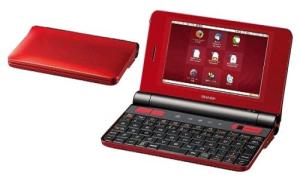Intel Vulnerable as Consumers Shift to Phones to Browse the Web – BusinessWeek.
By Ian King
Jan. 6 (Bloomberg) — Intel Corp.’s position as the gateway to the Internet will come under attack in 2010 as more consumers start going online via phones, tablets, e-readers and scaled- down laptops.
Qualcomm Inc., Marvell Technology Group Ltd. and Freescale Semiconductor Inc. are among the chipmakers demonstrating new kinds of Internet devices at this week’s Consumer Electronics Show in Las Vegas. Their goal: persuade consumers to ditch their Intel-powered personal computers as the primary way of going online.
“The next billion users that are going to connect to the Web aren’t going to be connected by the PC,” said Henri Richard, head of sales at Austin, Texas-based Freescale. “It’s going to be a multitude of devices.”
Intel, the world’s largest chipmaker, makes more than 80 percent of PC processors — the brains of computers. It aims to use its Atom product, which runs small laptops known as netbooks, to break into chips for wireless devices, a market IDC estimates will increase 14 percent to more than $46 billion in 2010. Its rivals are heading in the other direction: using phone chips to woo users of PCs and consumer electronics.
While the PC will remain the main way for people to go online, portable devices are chipping away at that dominance — with mobile phones leading the charge. Qualcomm, Freescale, Marvell and Texas Instruments Inc. are using chip technology developed by ARM Holdings Plc.
Reaching a Billion
By 2013, the number of phones regularly being used to access the Web will exceed 1 billion for the first time, a fivefold increase from 2006, according to Framingham, Massachusetts-based IDC. Over the same time period, the number of Internet-connected PCs will rise to 1.6 billion from 754 million, according to IDC.
“The push right now is to connect everyone and everything, and that’s why we’re seeing a plethora of devices,” said Jim McGregor, an analyst at Scottsdale, Arizona-based research firm In-Stat. “In terms of sheer numbers and usability, you can’t compete with a handheld. Everything migrates to a mobile.”
The Consumer Electronics Show will reveal which phone-chip makers have made progress persuading computer and consumer- electronics companies to use their components. Qualcomm, the world’s largest maker of phone chips, will show off a so-called smartbook made by Lenovo Group Ltd., China’s biggest computer maker.
That device will run on San Diego-based Qualcomm’s Snapdragon chip. Freescale will demonstrate similar small laptops based on its products, and Marvell will introduce products based on a new range of faster processors.
Apple Tablet?
Apple Inc., maker of the iPhone, also is planning to unveil a tablet computer this month, a person familiar with the matter said this week. Yesterday, Google Inc. introduced a touch-screen phone called the Nexus One.
It makes more sense to use smartphone technology to build tablets, e-readers and handheld computers, rather than relying on PC chips, said Sehat Sutardja, chief executive officer of Santa Clara, California-based Marvell. Smartphones offer the right mix of processing speed, low power consumption and touch screens, making them easy to convert into Internet devices, he said.
“A touch-screen smartphone is actually a small tablet PC,” said Sutardja, whose company supplies the main chip for Research In Motion Ltd.’s Blackberry. “The time for tablet devices is now.”
Armada Chips
In October, Marvell released a new line of chips called Armada. Those products can run fast enough to bring PC-level computing to e-readers and tablets, Sutardja said. Internet devices have previously failed to catch on with consumers because the chips that ran them were either too slow to make them useful or drew too much power, draining batteries, he said.
At CES, Intel CEO Paul Otellini plans to demonstrate mobile devices based on its chips.
“We remain committed to delivering the benefits of Intel architecture to handhelds and consumer electronics and believe that these devices will continue to become smarter with PC-like performance, computer and Internet capabilities,” said Claudine Mangano, a spokeswoman for the Santa Clara-based company. “This is Intel’s strength.”
Intel lost 1 cent to $20.87 yesterday in Nasdaq Stock Market trading. The shares added 39 percent in 2009. Qualcomm gained $1.13 to $48.07, and Marvell rose 40 cents to $21.43.
Intel’s challenge in pushing into phones and mobile devices is creating less power-hungry chips with similar performance. The company’s rivals on the phone side are trying to gauge how quickly that will happen. Intel chips will continue to draw three to four times as much power as Marvell’s products, Sutardja said. ARM, though, doesn’t expect phone chips to have an edge for long.
‘Smart Company’
“Intel’s a smart company and in the next couple of years they’ll have the same type of power and performance,” said Bob Morris, director of mobile computing for Cambridge, England- based ARM.
In the meantime, ARM chipmakers can gain an edge with electronics companies by selling chips that are cheaper than Intel’s, he said. They also can use Google’s free Android software, which works with ARM designs.
Electronic-book readers, fueled by the success of Amazon.com Inc.’s Kindle and Sony Corp. devices, are opening up another market for chips. For the first time, CES will have an area devoted to e-readers on the show floor.
That market will double next year to about 11 million units and then double again by 2013, according to Vinita Jakhanwal, an analyst at El Segundo, California-based ISuppli Corp.
As readers become more popular, they could become more general-purpose Internet devices, Freescale’s Richard said. His company makes the processors that power both the Kindle and Sony products, which account for about 75 percent of market sales.
For now, the black-and-white screens of e-readers may make them unfit for broader applications, said ISuppli’s Jakhanwal. Until color displays are introduced, consumers won’t accept e- readers as Web browsers, she said.









